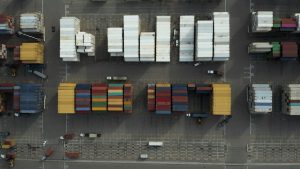The export of raw materials from the USA to Brazil is a significant trade operation that can face the challenge of non-payment issues. Addressing these concerns requires an understanding of the recovery system for unpaid exports, evaluating the feasibility of legal action, and implementing effective communication and debt collection strategies. Financial considerations are also crucial in managing debt recovery operations. This article delves into these aspects, providing insight into the multi-phase recovery process, legal considerations, and financial implications of debt recovery in the context of USA-Brazil raw material exports.
Key Takeaways
- The recovery system for unpaid raw material exports to Brazil involves a three-phase process that includes initial contact, escalation to attorneys, and potential litigation.
- Evaluating the feasibility of legal action is critical and should consider the debtor’s assets, likelihood of recovery, and the impact of legal costs and fees.
- Effective communication strategies, including using multiple channels and varying the frequency and intensity of collection attempts, play a vital role in debt recovery.
- Financial considerations in debt recovery operations involve understanding collection rates, fee structures, and managing claims to optimize the cost-benefit of legal actions.
- The decision to proceed with litigation requires careful consideration of upfront legal costs, potential outcomes, and the collection agency’s fee contingent on the age and size of the account.
Understanding the Recovery System for Unpaid Raw Material Exports
Phase One: Initial Contact and Information Gathering
The clock starts ticking immediately. Within the first 24 hours of reporting a non-payment issue, a multi-pronged approach is launched. Debtors receive the first of four letters, signaling the start of the recovery process. But it’s not just about sending letters; it’s about understanding who you’re dealing with.
Skip-tracing and investigations are conducted to unearth the most current financial and contact details of the debtor. This information is crucial for what comes next: persistent outreach. Our collectors don’t just knock once; they knock daily, utilizing every tool at their disposal—phone, email, text, fax—to secure a resolution.
If these efforts don’t yield fruit within 30 to 60 days, we’re ready to escalate. Phase Two isn’t just a step up; it’s a strategic shift, bringing our affiliated attorneys into play.
Here’s a snapshot of the initial outreach efforts:
- First of four letters sent via US Mail
- Comprehensive skip-tracing and debtor investigation
- Daily contact attempts through various channels
Should all attempts falter, the case transitions seamlessly to the next phase, ensuring no momentum is lost in the pursuit of what’s owed.
Phase Two: Escalation to Affiliated Attorneys
When initial recovery efforts falter, escalation is key. Your case is promptly forwarded to an attorney within the debtor’s jurisdiction. Expect swift action:
- A demand letter on law firm letterhead is drafted.
- Persistent phone contact attempts commence.
The goal is clear: secure payment through increased legal pressure.
If these efforts yield no resolution, a detailed report outlines the next steps. Communication is crucial; you’re informed at every turn. The decision to litigate hinges on this pivotal phase.
Phase Three: Litigation and Closure Recommendations
When the recovery process escalates to Phase Three, a critical juncture is reached. The decision to litigate hinges on a comprehensive evaluation of the debtor’s assets and the likelihood of recovery. If prospects appear dim, closure is advised, absolving clients from any financial obligations to our firm or affiliated attorneys.
In contrast, choosing litigation necessitates upfront legal costs, typically ranging from $600 to $700. These fees cover court costs, filing fees, and are contingent upon the debtor’s jurisdiction. Upon payment, our attorneys initiate legal proceedings to reclaim the full amount owed, including litigation expenses. Failure to recover funds results in case closure, with no further costs incurred by the client.
Our fee structure is competitive and varies based on claim volume and age. For instance, accounts under one year are subject to a 30% collection rate, while those over a year or under $1000 incur higher rates. Legal action mandates a 50% rate on amounts collected.
The table below outlines our collection rates:
| Claims Submitted | Accounts < 1 Year | Accounts > 1 Year | Accounts < $1000 | Attorney Placed Claims |
|---|---|---|---|---|
| 1-9 | 30% | 40% | 50% | 50% |
| 10+ | 27% | 35% | 40% | 50% |
Recovery processes and legal frameworks are tailored to navigate the complexities of USA-Brazil raw material exports, ensuring successful cross-border transactions.
Evaluating the Feasibility of Legal Action in Non-Payment Scenarios
Investigating Debtor’s Assets and Recovery Likelihood
Before initiating legal action, a meticulous assessment of the debtor’s financial standing is crucial. Identifying tangible assets and evaluating solvency sets the stage for recovery success. Due diligence in this phase mitigates futile legal pursuits.
- Asset Investigation: Scrutinize property, bank accounts, and business holdings.
- Solvency Analysis: Assess the debtor’s ability to satisfy the debt.
- Recovery Forecast: Estimate the likelihood of recouping the owed amount.
The feasibility of recovery dictates the next steps. If assets are insufficient, litigation may be ill-advised.
Costs must be weighed against potential recovery. Legal fees, court costs, and time investment require a careful balance. A strategic decision to litigate hinges on the probability of a favorable outcome.
Assessing the Impact of Legal Costs and Fees
Before leaping into litigation, a clear-eyed assessment of legal costs and fees is essential. Bold decisions require solid data. Consider the upfront costs: court costs, filing fees, and attorney retainers. These can range from $600 to $700, depending on jurisdiction.
- Upfront Legal Costs: $600 – $700
- Collection Rates: 30% – 50% (age & value dependent)
The decision to litigate hinges not just on the potential to recover debts, but also on the financial viability of the case. Weigh the initial investment against the collection rates and the age and value of the accounts. Remember, if litigation fails, you owe nothing further.
In assessing the feasibility of legal action, it’s not just about the odds of winning, but whether the juice is worth the squeeze.
Making an Informed Decision on Pursuing Litigation
When the recovery of unpaid raw material exports reaches a crossroads, the decision to litigate hinges on meticulous analysis. Weighing the potential for asset recovery against the upfront legal costs is crucial. Litigation may promise a resolution, but it comes with a price tag: court costs and filing fees averaging $600-$700.
Before committing to legal action, consider the following:
- The age and size of the account
- The debtor’s asset profile
- The likelihood of successful recovery
Costs are not the only factor. The collection rate is a pivotal metric, influencing the final decision. Here’s a snapshot of our fee structure:
| Claims Quantity | Account Age | Collection Rate |
|---|---|---|
| 1-9 | < 1 year | 30% |
| 1-9 | > 1 year | 40% |
| 1-9 | < $1000 | 50% |
| 10+ | < 1 year | 27% |
| 10+ | > 1 year | 35% |
| 10+ | < $1000 | 40% |
In the event of unsuccessful litigation, rest assured, you owe nothing further. This assurance provides a safety net, allowing for a more confident decision-making process.
Ultimately, the choice to pursue litigation is a strategic one, balancing potential gains with financial risks. It’s a calculated move, not to be taken lightly.
Strategies for Communication and Debt Collection
Utilizing Multiple Channels for Debtor Outreach
In the pursuit of resolving unpaid raw material exports, effective communication with debtors is paramount. Employing a multi-channel approach maximizes the chances of reaching a resolution. This includes phone calls, emails, text messages, and faxes, ensuring that the debtor is engaged through various touchpoints.
Persistence is key in debtor outreach. A structured approach, as outlined below, can lead to successful debt recovery:
- Initial contact via email and phone within the first 24 hours
- Regular follow-ups with increasing intensity
- Escalation to formal written notices
- Involvement of affiliated attorneys if necessary
By maintaining a consistent and assertive communication strategy, businesses can significantly improve the likelihood of debt recovery.
It’s crucial to tailor the outreach strategy to the debtor’s responsiveness and to employ persuasive negotiation strategies. The goal is to achieve a resolution that is satisfactory for both parties, ensuring the recovery of delinquent accounts.
Frequency and Intensity of Collection Attempts
The frequency and intensity of collection attempts are pivotal in the debt recovery process. Consistent communication is key to maintaining pressure on the debtor and underscores the seriousness of the matter. Initial efforts may involve daily contact for the first 30 to 60 days, utilizing various channels such as phone calls, emails, and letters.
The escalation of collection attempts must be strategic, increasing in intensity if initial contacts do not yield results. This may include more direct forms of communication or the involvement of legal representatives.
A structured approach to collection attempts can be outlined as follows:
- Initial phase: Daily attempts using multiple communication methods.
- Escalation phase: Increased pressure through direct communication and legal notices.
- Final phase: Decision on litigation based on debtor’s response and asset investigation.
Understanding the complexities of debt collection, especially in sectors like biotechnology, luxury goods, and automotive trade, is crucial for financial stability and successful international trade relationships.
The Role of Attorneys in Debt Recovery Efforts
Attorneys play a pivotal role in the debt recovery process, especially when initial collection efforts fail. Phase Two of the recovery system for company funds involves forwarding the case to a local attorney, who will then take a more formal approach.
The attorney’s involvement adds legal weight to the demand for payment. Drafting demand letters on law firm letterhead and making direct contact with the debtor often prompts a more immediate response.
If the debtor remains unresponsive, the attorney will provide further action recommendations, which may include litigation. The decision to escalate to court proceedings is critical, as it involves additional costs and fees. Here’s a breakdown of potential upfront legal costs:
| Jurisdiction | Filing Fees |
|---|---|
| Debtor’s Local | $600 – $700 |
Upon deciding to litigate, you will be responsible for these costs, but if the litigation efforts do not result in recovery, you owe nothing further to the firm or the affiliated attorney.
Financial Considerations in Debt Recovery Operations
Understanding Collection Rates and Fee Structures
When delving into the realm of debt recovery, grasping the nuances of collection rates and fee structures is pivotal. Collection rates vary depending on several factors, including the age of the account and the total amount owed. For instance, accounts under one year may incur a 30% fee on the amount collected, while older accounts could see a 40% fee. Smaller debts under $1000 are subject to a 50% collection rate.
Legal action introduces additional costs, such as court and filing fees, typically ranging from $600 to $700. These upfront costs are necessary for litigation to proceed. However, if the collection attempts through litigation fail, the client owes nothing further to the firm or the affiliated attorney.
Understanding collection rates and legal action in debt recovery for exporters, emphasizing the importance of financial assessment and structured recovery systems.
Here’s a quick breakdown of the fee structure based on the number of claims:
| Claims Submitted | Accounts < 1 Year | Accounts > 1 Year | Accounts < $1000 | Attorney Placed Accounts |
|---|---|---|---|---|
| 1-9 | 30% | 40% | 50% | 50% |
| 10+ | 27% | 35% | 40% | 50% |
It’s essential to weigh these financial considerations against the potential recovery to make an informed decision.
Analyzing the Cost-Benefit of Legal Action
When considering legal action for unpaid raw material exports, a meticulous cost-benefit analysis is crucial. Deciding whether to litigate hinges on potential recovery versus legal expenses. Legal costs, including court fees and attorney rates, can quickly accumulate, making it essential to weigh them against the recoverable amount.
Recovery likelihood plays a pivotal role in this equation. If the debtor’s assets are insufficient or unreachable, legal action may result in a financial loss. Conversely, a strong case with a high chance of asset recovery can justify the initial investment. Here’s a simplified breakdown of potential legal costs:
| Legal Expense | Estimated Cost (USD) |
|---|---|
| Court Costs | $600 – $700 |
| Filing Fees | Included in Court Costs |
| Attorney Fees | Contingent on Recovery |
Remember, these costs are upfront and non-recoverable if the litigation fails. The decision to pursue legal action should be made after considering all financial implications and the debtor’s payment history.
In the steel industry, a tailored 3-phase recovery system is often employed. Legal complexities and currency exchange risks in USA-Brazil trade necessitate a strategic approach to debt collection.
Managing Small Claims and Aged Accounts
When dealing with small claims or accounts that have aged beyond a year, a tailored approach is essential. Prioritize cost-effective strategies to maximize recovery while minimizing expenses. For small claims, especially those under $1,000, consider the proportionality of legal action versus potential recovery.
- Evaluate the age of the account and the amount owed
- Determine the likelihood of successful recovery
- Assess whether the cost of recovery is justified
In cases where accounts are significantly aged or the amount is minimal, it may be more prudent to write off the debt rather than pursue aggressive collection tactics.
Collection rates vary based on the age of the account and the number of claims. Here’s a quick reference:
| Age of Account | 1-9 Claims Rate | 10+ Claims Rate |
|---|---|---|
| Under 1 year | 30% | 27% |
| Over 1 year | 40% | 35% |
| Under $1000 | 50% | 40% |
Remember, the goal is to achieve a balance between the effort expended and the likelihood of recovery. In some instances, maintaining a relationship with the debtor may be more valuable than the immediate recovery of funds.
Navigating the complexities of debt recovery requires a strategic approach to ensure financial stability and success. At Debt Collectors International, we specialize in providing tailored solutions that cater to the unique needs of your industry. Our experienced team is equipped to handle every aspect of debt collection, from skip tracing to judgment enforcement. Don’t let unpaid debts disrupt your business operations. Take the first step towards reclaiming what’s rightfully yours by visiting our website for a free rate quote and learn more about our ‘No Recovery, No Fee’ policy. Act now and ensure your financial considerations are in expert hands.
Frequently Asked Questions
What happens during Phase Three if the possibility of recovery is not likely?
If after investigating the facts and the debtor’s assets we determine recovery is unlikely, we recommend closure of the case. In this scenario, you will owe nothing to our firm or our affiliated attorney.
What are my options if I decide not to proceed with litigation in Phase Three?
If you choose not to proceed with legal action, you can withdraw the claim without any cost, or allow us to continue standard collection activities such as calls, emails, and faxes.
What upfront legal costs are required if I decide to proceed with litigation?
Should you decide to proceed with legal action, you’ll need to pay upfront costs like court costs and filing fees, typically ranging from $600.00 to $700.00, depending on the debtor’s jurisdiction.
What happens if attempts to collect via litigation fail?
If we are unable to collect through litigation, the case will be closed and you will owe nothing to our firm or our affiliated attorney.
How does the fee structure work for the collection of debts?
Our fee structure is competitive and depends on the number of claims and age of accounts. Rates can vary from 27% to 50% of the amount collected, depending on these factors.
What can I expect during Phase One of the Recovery System?
Within 24 hours of placing an account, we send letters, perform skip-tracing, and make daily attempts to contact the debtor using various methods for the first 30 to 60 days. If these attempts fail, we escalate to Phase Two.





